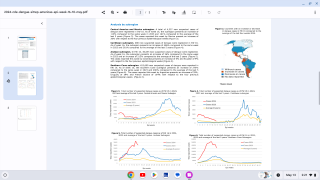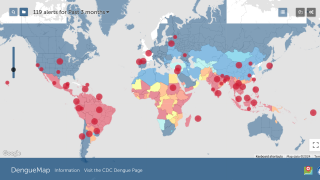'Disease Danger Days’ Increasing

The number of mosquito “disease danger days” are increasing across much of the USA, reported Climate Central.
These disease danger days, which is when temperatures are between 61 degrees and 93 degrees Fahrenheit, represent a greater risk for mosquito-borne diseases transmissions, which can be deadly to humans.
Climate Central analyzed the number of days with temperatures in the risk zone during spring, summer, and fall. Of the 244 cities reviewed, 94 percent (229 cities) have an increasing number of disease danger days.
Of the cities analyzed in this report, Honolulu has the greatest increase of days in the peak range, with an additional 36 days each year, on average, during spring, summer, and fall.
Out of the 244 cities in the analysis, only 12 (5 percent) are seeing a decrease in the number of disease danger days during this time period.
Three California cities are ranked on the top-ten list of biggest increases in disease danger days.
Other cities in the top 10 list include southern and southwestern cities like Las Cruces, New Mexico, El Paso, Texas and Tucson, Arizona, where temperatures are suitable for mosquito survival and some disease transmission already occurs.
A few northern cities also make this top-10 list of greatest increases in disease danger days, including Helena, Montana, and Erie, Pennsylvania.
Of the possible 275 days analyzed for this report, Honolulu and San Juan fall in the disease transmission zone for the entire stretch.
Additionally, the temperature change may also actually make some locations too hot for mosquito survival and disease transmission.
As an example, there are fewer disease danger days in Phoenix since 1970.
This is likely because the number of days above 95 degrees Fahrenheit in Phoenix is also going up, and 95 degrees is beyond the range of disease transmission.
This analysis did not consider winter temperatures, and in some of the cities analyzed, diseases can still be transmitted during that time.
As climate change increases temperatures during winter months, transmission could become possible year-round in some places across the continental U.S., beginning with South Florida.
Temperature plays a major role in the viability of mosquitoes’ range and survival and can affect mosquitoes at every stage of their life cycle.
For Aedes mosquitoes, development and survival are limited to temperatures above 50 degrees Fahrenheit and below 102 degrees for Aedes aegypti, and above 59 degrees, but below 95 degrees for Aedes albopictus.
For these two related species, peak rates for various parts of their life cycle generally occur between 73 degrees and 93 degrees.
Culex mosquitoes thrive in temperatures between 50 degrees and 95 degrees. Though adults survive for the longest time at temperatures between 60 degrees and 68 degrees, studies have found that they develop fastest at temperatures between 82 degrees and 89 degrees.
The land area of the U.S. most suitable for Aedes albopictus mosquitoes is projected to increase from 5 percent to about 50 percent by 2100, putting 60 percent of the northeastern U.S. population at risk for the diseases carried by this mosquito, including West Nile, dengue and Zika viruses.
Overall, the number of mosquito disease danger days is increasing across much of the U.S., representing a greater risk for transmission of mosquito-borne diseases, concluded this study.
Temperature trends were calculated using average daily temperature data from the Applied Climate Information System (rcc-acis.org). Years with more than 30 days of missing data were excluded from the analysis. The temperature range of disease transmission (61-93ºF) as well as the range for peak transmission (79-84ºF) was chosen based on the findings in Mordecai et al. 2017.
Climate Central's Jennifer Brady contributed data analysis for this report, and Marta Shocket, a postdoctoral scholar in Erin Mordecai’s lab at Stanford University, for reviewing the analysis and providing feedback on an earlier version of this report.
Recent related research:
- Orkin's Top 10 Mosquito Cities list ranks metro areas by the number of new mosquito customers served from April 1, 2017, to March 31, 2018.
- Gulf Coast storms have empowered the spreading of neglected tropical diseases (NTDs), such as West Nile, Chagas, Chikungunya, Typhus and Dengue viruses.
- Pockets of "microhabitats" within a county could vary in suitability for mosquitoes compared to the average conditions of the county as a whole--warmer urban settings, for instance, may still be suitable for the two Aedes species in some counties not identified as such in the study.
Our Trust Standards: Medical Advisory Committee

























